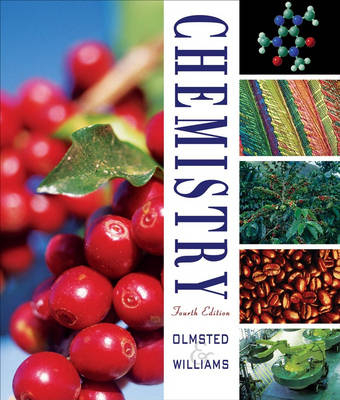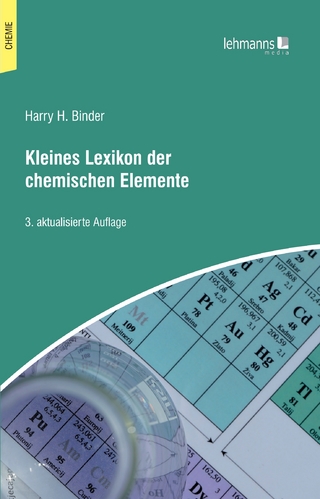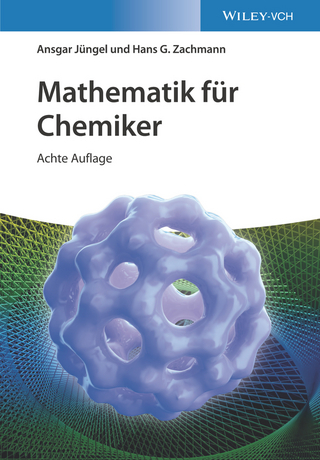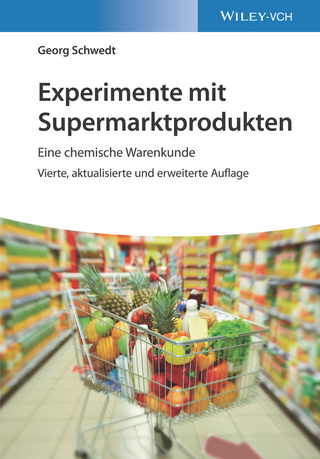
Chemistry
John Wiley & Sons Inc (Verlag)
978-0-471-47811-9 (ISBN)
- Titel ist leider vergriffen;
keine Neuauflage - Artikel merken
100% Pure Chemical Understanding Every morning many of us are energized by a cup of coffee. Imagine if you were as energized by understanding the chemistry in your morning cup--from the coffee trees, which fill red coffee berries with caffeine and a variety of other chemical substances, to the feathery crystals formed by the caffeine molecules, to the decaffeinating machines, which use liquid solvents to remove this stimulant from some of the beans. Now, that's real chemical understanding! Olmsted and Williams' Fourth Edition of Chemistry focuses on helping you see and think about the world (and even your coffee) as a chemist. This text helps you understand how chemical phenomena are governed by what happens at the molecular level, apply critical thinking skills to chemical concepts and problems, and master the basic mathematical techniques needed for quantitative reasoning. You'll see the world as chemists do, and learn to appreciate the chemical processes all around us. A Fourth Edition with a lot of new perks!
Revisions include a new, early energy chapter; revised coverage of bonding; expanded coverage of intermolecular forces; and increased coverage of multiple equilibria, including polyprotic acids. New pedagogy strengthens students' critical thinking and problem-solving skills. Visual Summaries at the end of each chapter use molecular and diagrammatic visual elements to summarize essential skills, concepts, equations, and terms. eGrade Plus provides an integrated suite of teaching and learning resources, including a complete online version of the text, links between problems and relevant sections in the online text, practice quizzes, the Visual Tutor, Interactive LearningWare problems, and lab demos, as well as homework management and presentation features for instructors.
John Olmsted III is Professor Emeritus of Chemistry at California State University, Fullerton, from which he retired in 2003 after nearly 40 years of teaching and research in general and experimental physical chemistry. John was honored as the CSUF Outstanding Professor in 1997-98 and served as department chair from 1998 to 2001. In addition to 25 years at CSUF, he taught for 12 years at the American University of Beirut. He had visiting teaching/research appointments at UCLA and the University of North Carolina at Chapel Hill and did research at the Max-Planck-Institute fur Biophysikalische Chemie (Gottingen, Germany), the University of California at San Diego, and Sandia National Laboratory in Albuquerque, NM. John received his BS degree in chemistry from Carnegie Institute of Technology (now Carnegie-Mellon University) and his PhD in physical chemistry from UC Berkeley, where he also did postdoctoral work at the Lawrence Berkeley Laboratory. He has more than 30 referred research publications and has also published regularly on chemical education topics in the Journal of Chemical Education. In his retirement, besides continuing to write chemistry textbooks, John Keeps busy with his interests in gardening, photography, and the philosophy of chemistry. He and his wife Eileen enjoy traveling, dancing, and visiting with their three married children and two grandchildren. Greg Williams is an Adjunct Professor of Chemistry at the University of Oregon. He earned an undergraduate degree in chemistry at UCLA and a Ph.D. in inorganic chemistry at Princeton University. He has taught and conducted research at the University of Oregon, California State University, Fullerton, UCLA, and the University of California, Irvine. Outside the classroom, Greg's professional work is concentrated on developing graphics, digital animation, and interactive multimedia for teaching chemistry. When he is not teaching or writing about chemistry, Greg can be found somewhere in the western United States, backpacking, climbing, skiing, fly fishing, or kayaking. He also sings low bass with the Eugene Vocal Arts Ensemble. Greg lives in Eugene, Oregon, with his wife Trudy Cameron, a Professor of Economics at the University of Oregon, and their daughters, Casey and Perry. He absolutely insists on enjoying life.
Chapter 1. The Science of Chemistry. 1.1 What Is Chemistry? 1.2 Atoms, Molecules, and Compounds. 1.3 The Periodic Table of the Elements. 1.4 Characteristics of Matter. 1.5 Measurements in Chemistry. 1.6 Calculations in Chemistry. 1.7 Chemical Problem Solving. Chapter 2. The Atomic Nature of Matter. 2.1 Atomic Theory. 2.2 Atomic Architecture: Electrons and Nuclei. 2.3 Atomic Diversity: The Elements. 2.4 Counting Atoms: The Mole. 2.5 Charged Atoms: Ions. Chapter 3. The Composition of Molecules. 3.1 Representing Molecules. 3.2 Naming Chemical Compounds. 3.3 Formulas and Names of Ionic Compounds. 3.4 Amounts of Compounds. 3.5 Determining Chemical Formulas. 3.6 Aqueous Solutions. Chapter 4. Chemical Reactions and Stoichiometry. 4.1 Writing Chemical Equations. 4.2 The Stoichiometry of Chemical Reactions. 4.3 Yields of Chemical Reactions. 4.4 The Limiting Reactant. 4.5 Precipitation Reactions. 4.6 Acid-Base Reactions. 4.7 Oxidation-Reduction Reactions. Chapter 5. The Behavior of Gases. 5.1 Pressure. 5.2 Describing Gases. 5.3 Molecular View of Gases. 5.4 Additional Gas Properties. 5.5 Gas Mixtures. 5.6 Gas Stoichiometry. 5.7 Chemistry of the Atmosphere. Chapter 6. Energy and Its Conservation. 6.1 Types of Energy. 6.2 Thermodynamics. 6.3 Energy Changes in Chemical Reactions. 6.4 Measuring Energy Changes. 6.5 Enthalpy. 6.6 Energy Sources. Chapter 7. Atoms and Light. 7.1 Characteristics of Atoms. 7.2 Characteristics of Light. 7.3 Absorption and Emission Spectra. 7.4 Properties of Electrons. 7.5 Quantization and Quantum Numbers. 7.6 Shapes of Atomic Orbitals. 7.7 Sunlight and the Earth. Chapter 8. Atomic Energies and Periodicity. 8.1 Orbital Energies. 8.2 Structure of the Periodic Table. 8.3 Electron Configurations. 8.4 Periodicity of Atomic Properties. 8.5 Energetics of Ionic Compounds. 8.6 Ions and Chemical Periodicity. Chapter 9. Fundamentals of Chemical Bonding. 9.1 Overview of Bonding. 9.2 Lewis Structures. 9.3 Molecular Shapes: Tetrahedral Systems. 9.4 Other Molecular Shapes. 9.5 Properties of Covalent Bonds. Chapter 10. Theories of Chemical Bonding. 10.1 Localized Bonds. 10.2 Hybridization of Atomic Orbitals. 10.3 Multiple Bonds. 10.4 Molecular Orbital Theory: Diatomic Molecules. 10.5 Three-Center - Orbitals. 10.6 Extended - Systems. 10.7 Band Theory of Solids. Chapter 11. Effects of Intermolecular Forces. 11.1 Real Gases and Intermolecular Forces. 11.2 Types of Intermolecular Forces. 11.3 Liquids. 11.4 Forces in Solids. 11.5 Order in Solids. 11.6 Phase Changes. Chapter 12. Properties of Solutions. 12.1 The Nature of Solutions. 12.2 Determinants of Solubility. 12.3 Characteristics of Aqueous Solutions. 12.4 Colligative Properties. 12.5 Between Solutions and Mixtures. Chapter 13. Macromolecules. 13.1 Starting Materials for Polymers. 13.2 Free Radical Polymerization. 13.3 Condensation Polymerization. 13.4 Types of Polymers. 13.5 Carbohydrates. 13.6 Nucleic Acids. 13.7 Proteins. Chapter 14. Spontaneity of Chemical Processes. 14.1 Spontaneity. 14.2 Entropy: The Measure of Dispersal. 14.3 Entropies of Pure Substances. 14.4 Spontaneity and Free Energy. 14.5 Some Applications of Thermodynamics. 14.6 Bioenergetics. Chapter 15. Kinetics: Mechanisms and Rates of Reactions. 15.1 What Is a Reaction Mechanism? 15.2 Rates of Chemical Reactions. 15.3 Concentration and Reaction Rates. 15.4 Experimental Kinetics. 15.5 Linking Mechanisms and Rate Laws. 15.6 Reaction Rates and Temperature. 15.7 Catalysis. Chapter 16. Principles of Chemical Equilibrium. 16.1 Describing Chemical Equilibria. 16.2 Properties of Equilibrium Constants. 16.3 Thermodynamics and Equilibrium. 16.4 Shifts in Equilibrium. 16.5 Working with Equilibria. 16.6 Equilibria in Aqueous Solutions. Chapter 17. Aqueous Acid-Base Equilibria. 17.1 Proton Transfers in Water. 17.2 The pH Scale. 17.3 Weak Acids and Bases. 17.4 Recognizing Acids and Bases. 17.5 Acidic and Basic Salts. 17.6 Factors Affecting Acid Strength. 17.7 Multiple Equilibria. Chapter 18. Applications of Aqueous Equilibria. 18.1 Buffer Solutions. 18.2 Capacity and Preparation of Buffer Solutions. 18.3 Acid-Base Titrations. 18.4 Solubility Equilibria. 18.5 Complexation Equilibria. Chapter 19. Electron Transfer Reactions. 19.1 Recognizing Redox Reactions. 19.2 Balancing Redox Reactions. 19.3 Galvanic Cells. 19.4 Cell Potentials. 19.5 Free Energy and Electrochemistry. 19.6 Redox in Action. 19.7 Electrolysis. Chapter 20. The Transition Metals. 20.1 Overview of the Transition Metals. 20.2 Coordination Complexes. 20.3 Bonding in Coordination Complexes. 20.4 Metallurgy. 20.5 Applications of Transition Metals. 20.6 Transition Metals in Biology. Chapter 21. The Main Group Elements. 21.1 Lewis Acids and Bases. 21.2 Hard and Soft Lewis Acids and Bases. 21.3 The Main Group Metals. 21.4 The Metalloids. 21.5 Phosphorus. 21.6 Other Nonmetals. Chapter 22. Nuclear Chemistry and Radiochemistry. 22.1 Nuclear Stability. 22.2 Nuclear Decay. 22.3 Induced Nuclear Reactions. 22.4 Nuclear Fission. 22.5 Nuclear Fusion. 22.6 Effects of Radiation. 22.7 Applications of Radioactivity. Appendix A: Scientific Notation. Appendix B: Quantitative Observations. Appendix C: Ionization Energies and Electron Affinities. Appendix D: Standard Thermodynamic Functions. Appendix E: Equilibrium Constants. Appendix F: Standard Reduction Potentials. Solutions to Odd-Numbered Problems. Photo Credits. Glossary. Index of Equations. Index.
| Erscheint lt. Verlag | 20.12.2004 |
|---|---|
| Zusatzinfo | Illustrations (some col.) |
| Verlagsort | New York |
| Sprache | englisch |
| Maße | 228 x 288 mm |
| Gewicht | 2198 g |
| Einbandart | gebunden |
| Themenwelt | Naturwissenschaften ► Chemie ► Allgemeines / Lexika |
| ISBN-10 | 0-471-47811-3 / 0471478113 |
| ISBN-13 | 978-0-471-47811-9 / 9780471478119 |
| Zustand | Neuware |
| Haben Sie eine Frage zum Produkt? |
aus dem Bereich


